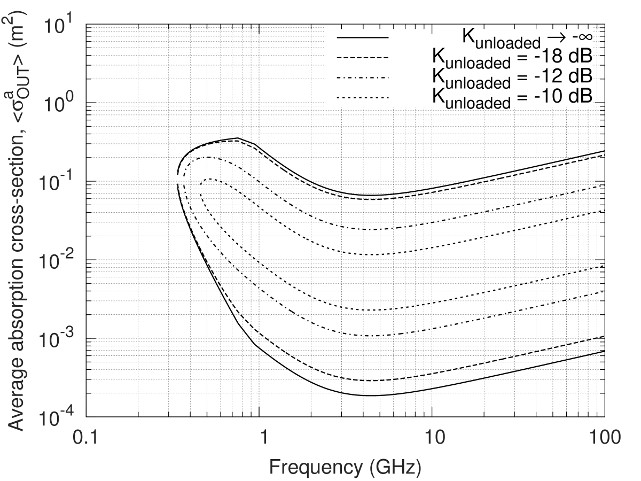Paper on the measurable range of absorption cross-section in a reverberation chamber
Paper on the measurable range of absorption cross-section in a reverberation chamber accepted for publication in IEEE Transaction on Electromagnetic Compatibility.
This paper presents an improved uncertainty model for the average absorption cross section in a reverberation chamber that accounts for the loading effect of the object being measured and the presence of non-stochastic energy in the chamber, as characterized by the Rician K-factor. The extended uncertainty formula has been applied to predict the range over which absorption cross-section measurements can be made with a defined relative uncertainty in a chamber of given geometry, using both simple models for the reverberation chamber and the measured quality-factor and K-factor.

The graph above shown the estimated boundaries on the ACS of an object in a small chamber for a relative uncertainty of 30% and various loading dependent determined from the new uncertainty estimate using the semi-empirical model for the chamber Q-factor. The model has been validated using measurements on a set of absorbing cubes of different sizes compared to Mie Series calculation on sphere of equivalent surface area. The extended error model is particularly useful for the design of reverberation chambers and experiments for absorption cross-section measurements across a wide range of application areas.
This work was part of the collaborative shielding measurement of electrically large enclosures with contents project between Huawei Technologies and the AEG. The full details are in the paper (Flintoft et al., 2016).
References
- Flintoft, I.D., S. J, B., Parker, S.L., Marvin, A.C., Dawson, J.F. and Robinson, M.P., 2016. On the measureable range of absorption cross-section in a reverberation chamber. IEEE Transactions on Electromagnetic Compatibility, 58(1), pp.22–29.
Average absorption cross section can be measured in a reverberation chamber with an uncertainty estimated from the number of independent samples of the chamber transfer function taken during the measurement. However, the current uncertainty model does not account the loading effect of the object being measured or the presence of nonstochastic energy in the chamber, as characterized by the Rician K-factor. Here, the uncertainty model for the absorption cross-section measurements has been extended to include both of these effects for the case of stepped mechanical tuning with a paddle and frequency tuning. The extended uncertainty formula has been applied to predict the range over which absorption cross-section measurements can be made with a defined relative uncertainty in a chamber of given geometry, using both simple models for the reverberation chamber and the measured quality-factor and K-factor. The model has been validated using measurements on a set of absorbing cubes of different sizes compared to Mie Series calculation on sphere of equivalent surface area. The extended error model is particularly utile for the design of reverberation chambers and experiments for absorption cross-section measurements across a wide range of application areas.
@article{Flintoft2016, author = {Flintoft, I. D. and S. J, Bale and Parker, S. L. and Marvin, A. C. and Dawson, J. F. and Robinson, M. P.}, title = {On the measureable range of absorption cross-section in a reverberation chamber}, journal = {IEEE Transactions on Electromagnetic Compatibility}, year = {2016}, volume = {58}, number = {1}, pages = {22--29}, month = feb, issn = {0018-9375}, note = {Date of acceptance: 08/11/2015. © 2016 IEEE. Personal use of this material is permitted. Permission from IEEE must be obtained for all other uses, in any current or future media, including reprinting/republishing this material for advertising or promotional purposes, creating new collective works, for resale or redistribution to servers or lists, or reuse of any copyrighted component of this work in other works.}, doi = {10.1109/TEMC.2015.2499841}, file = {:pdfs/TEMC58-Flintoft-22.pdf:PDF}, keywords = {absorption cross-section, reverberation chamber, Rician K-factor, uncertainty analysis}, postprint = {https://pure.york.ac.uk/portal/files/43360220/TEMC_Flintoft_et_al.pdf}, publisher = {IEEE} }
